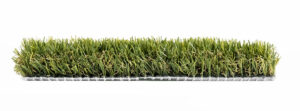How do you find the best possible artificial grass for your project? The answer is simple: do your research! That’s why we created an artificial grass technology cheat sheet, just for you! Learn all about essential features, application-specific technology, and what to avoid.
But before we begin, it’s important that you have an understanding of your project goals. Important considerations like kids, pets, and foot traffic determine the best artificial grass technology option for you. That’s because different features are specifically built for certain applications. For example, do you want a yard to increase curb appeal or one built to handle pick-up soccer games?
So, without further ado, we invite you to discover the amazing world of artificial grass technology!
Below are key features of artificial grass that can help determine the right product for your project!
Blade Shapes
There’s a lot more to artificial grass blades than meets the eye! A blade’s shape and material consistency affects how it looks, feels, and holds up to foot traffic. Here are seven essential blade shapes that every prospective buyer should know about!
- C Blades
- V Blades
- W / Wave Blades
- Ω / Omega Blades
- Diamond Blades
- Flat Blades
Yarn Quality
Just as important as blade shape is the quality of the yarn itself! Yarn is an industry term to describe the material used to create the blades. The most common materials for yarn are nylon, polyethylene, and polypropylene, with polyethylene being the most widely used. However, it’s important to know that there are actually several different grades of polyethylene, including C2, C4, C6, and C8. The number indicates the number of carbon molecules in the polymer. Most artificial turf on the market is made from low-grade C2 and polyethylene, but at Turf Distributors, we only use C4 and above, plus most products feature C8 Durablade technology.
Backings

Artificial turf backings bind blades together and allow moisture to escape into the ground below. Quality backings create more comfortable living environments by quickly whisking away water. Below are the different types of backings we offer!
- CoolFlow
- Optimum Flow backings
- Polyurethane backings
- Latex backings
- FlexGrip backings
- ArmorLoc
- Silverback coating
Thatching

The tiny fiber strands woven into artificial grass are known as thatching. They are small, thin, and typically gold in color. They are designed to look like the thin layer of grass blades that are at the base of a real lawn. This little touch goes a long way toward creating a more realistic product. It also adds visual interest and helps to deflect heat.
Infill
Infill is the gritty, sand-like material that you brush into artificial turf that helps keep turf from flattening and matting over time.
Sports Turf
- Slit filament blades are made to endure heavy use without ripping or falling out. They feature a webbed design which increases durability and acts as a barrier against infill migration, minimizing maintenance costs.
- Monofilament blades accurately recreate the appearance of living grass. They can be mixed with slit filament blades to create tough, natural-looking sports turf.
For a deeper dive into the different technologies, click here to learn more.

